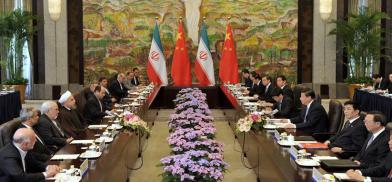China will dominate Persian Gulf through strategic pact with Iran; major implications for region
The PLA presence in Iran, which may rise, should be seen in conjunction with PLA presence in Pakistan, Sri Lanka, and in the garb of civilians in development projects around the world, the Middle East and Oman included, writes Lt Gen Prakash Katoch (retd) for South Asia Monitor

The Iran-China Comprehensive Strategic Partnership deal signed on March 27 is a 25-year agreement that cement relations of both countries in the political, economic, and military fields. Last year the US media had said that Iran’s desperation has pushed it into the arms of China, which has the technology and appetite for oil that Iran needs.
But then the obvious push came from the US unilaterally pulling out from the Iran nuclear deal and imposing crippling sanctions to blacklist Iran’s financial system.
Though Iran has not released official details of the deal, it is widely known that China is to invest some $400 billion in Iran in exchange for oil as part of the deal. It maybe recalled that in 2004, China signed a 25-year contract to import 110 MT LNG from Iran and another contract worth $100 billion adding additional 250 MT LNG to China's energy supply, to be extracted from Iran's Yadavaran oil field over a 25-year period. In 2009, Iran and China signed two deals: a $1.76 billion contract for initial development of the North Azadegan oil field in western Iran and a three-year $3.39 billion deal to produce LNG in Iran's South Pars/North Dome Gas-Condensate field.
Iran-based green experts revealed in 2011 that Iran granted China exclusive rights to build necessary infrastructure in three large regions, plus the right to maintain and increase People's Liberation Army (PLA) strengths here, controlling the movement of Iranians in and out of these territories without permission from the Iranian government. This is akin to some Chinese projects in Pakistan occupied Kashmir where the local population is not permitted entry. According to green experts, China also gave an undertaking that it would defend Iran like its own territory if attacked. This again is akin to Beijing’s undertaking to Pakistan.
Strategic pact
The new strategic pact will see Iran and China cooperate in every possible field including military and, perhaps even, nuclear. Notably, in 2001, Iran and Russia had signed a 10-year cooperation agreement, mainly in the nuclear field which was subsequently extended to 20 years. But China is notorious for nuclear proliferation, not Russia. The PLA presence in Iran, which may rise, should be seen in conjunction with PLA presence in Pakistan, Sri Lanka, and in the garb of civilians in development projects around the world, the Middle East and Oman included.
Besides, China has access to the entire coast of Pakistan including PLA presence in Gwadar and upcoming joint military base in the Jiwani peninsula. China’s economic corridors through Pakistan and Myanmar and port developments in the Indian Ocean Region have an implicit strategic design.
America under President Joe Biden is pushing China and Russia closer. Besides, China has always embraced any country targeted by US sanctions, be it Iran or North Korea. If North Korea is getting ready to deploy a new submarine capable of launching ballistic missiles, Beijing would be more than happy with INDOPACOM (US Indo-Pacific Command) already concerned with China’s missile arsenal. Why would China not want to dominate the Persian Gulf knowing its importance to the US when Iran by itself has been threatening blockades in the past if it were to be attacked? Would Beijing’s leverage in the region not go up with Biden getting ready to hand over Afghanistan to the Taliban? Would China not be thrilled that the Houthi continue to target Saudi facilities that the US has vowed to defend?
China's push in Middle East
Already contending with the US in Africa, China has opened a new chapter in the Middle East with its Foreign Minister Wang Yi forwarding a five-point initiative to achieve security and stability in the Middle East. Beijing obviously wants to take the lead role in a region in which the US has been largely bombing and indulging in regime change. Wang even suggests a two-nation solution to resolve the Israel-Palestine issue - somewhat hilarious after smothering Hong Kong despite its ‘one country two systems’ slogan.
Interestingly, Wang’s proposals for the Middle East came just before signing the Comprehensive Strategic Partnership deals with Iran. Is there a connection especially with the deal automatically giving China leverage over Hamas and Hezbollah?
The issue of the US rejoining the nuclear deal is presently stalemated with Iran wanting the US to lift all sanctions before talks can be held, whereas, Biden without lifting any sanctions has said that Iran must first act to fulfill commitments it scaled back in response to US sanctions. However, on March 28, Iranian President Hassan Rouhani stated in a televised speech, “We’re ready for the lifting of sanctions if obstacles are removed, all or at least some sanctions can be lifted.” This indicates that part lifting of sanctions is acceptable to Iran. It gives a window of opportunity.
Taking on China
Iran will otherwise remain a hotspot for Washington, which the US may find difficult to resolve if it continues with full sanctions. What will be the repercussions of the US using military force against Iran too is not difficult to guess, escalation included.
Finally, the strength of the US has been its military and economy. China is catching up and by all indications, President Xi Jinping has the will to use force when compelling strategic interests are at stake.
Biden said on March 25 that he would prevent China from passing the United States to become the most powerful country in the world. However, his administration needs to match Chinese designs which go beyond just military and economy.
(The author is an Indian Army veteran. The views are personal)










Post a Comment